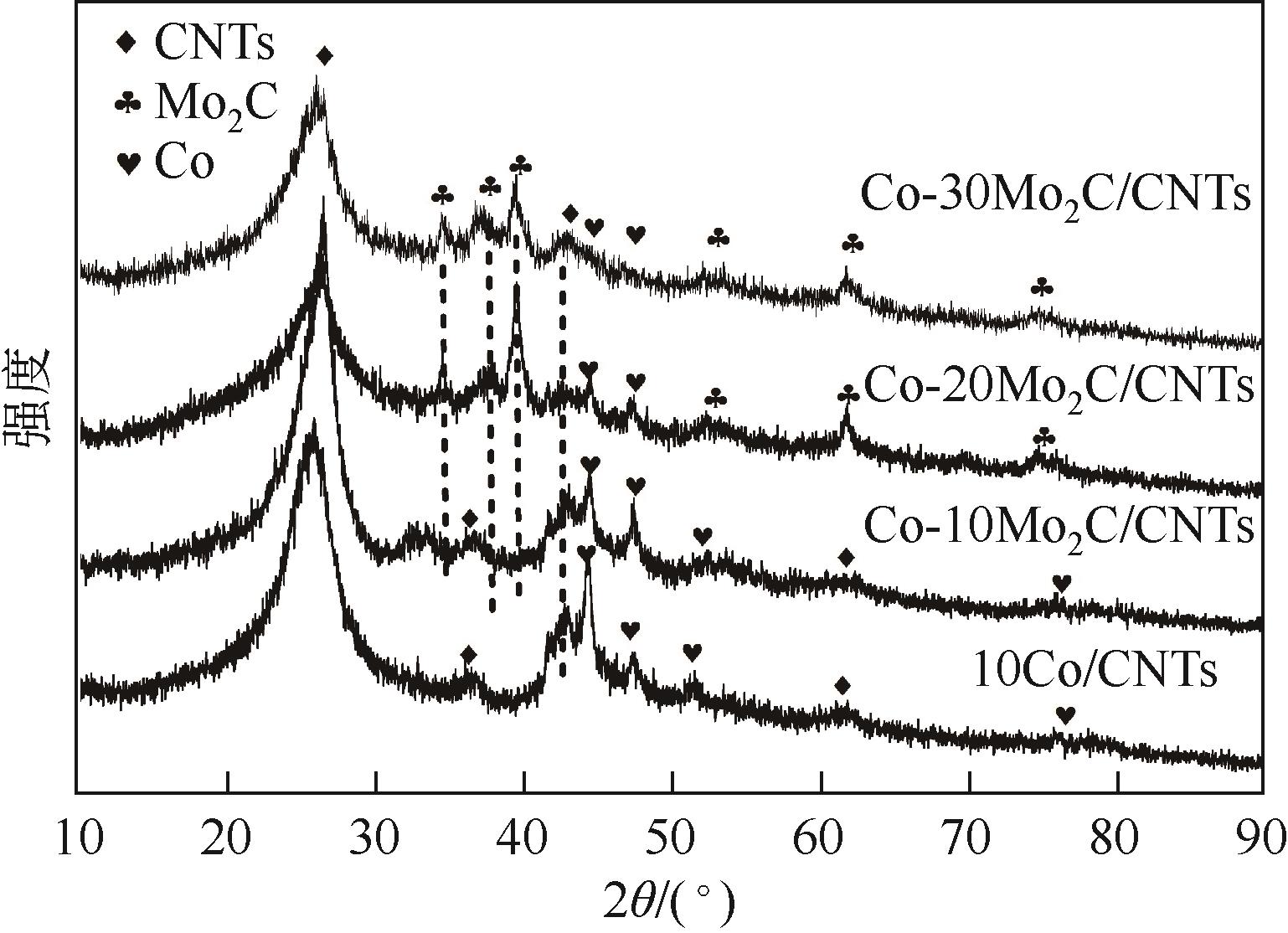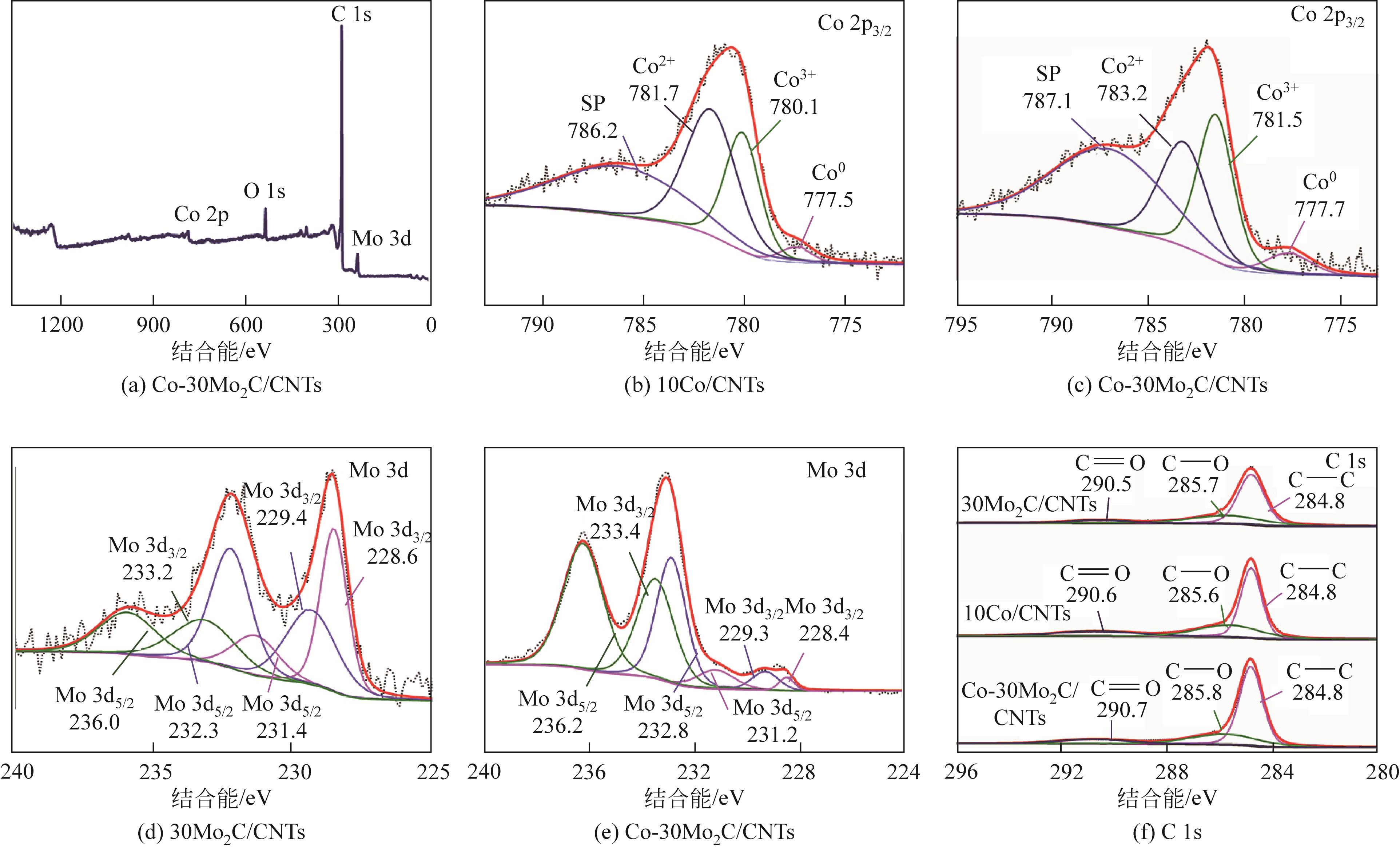Chemical Industry and Engineering Progress ›› 2023, Vol. 42 ›› Issue (11): 5730-5737.DOI: 10.16085/j.issn.1000-6613.2022-2286
• Industrial catalysis • Previous Articles Next Articles
In-situ synthesis of Mo2C and enhancement of Co based catalyst for hydrogen production from ammonia borane hydrolysis
- School of Chemistry and Chemical Engineering, Henan Polytechnic University, Jiaozuo 454000, Henan, China
-
Received:2022-12-09Revised:2023-03-23Online:2023-12-15Published:2023-11-20 -
Contact:LIU Xianyun
Mo2C的原位合成及增强Co基催化剂氨硼烷水解产氢性能
- 河南理工大学化学化工学院,河南 焦作 454000
-
通讯作者:刘宪云 -
作者简介:段继转(1999—),女,硕士研究生,研究方向为纳米催化材料的制备及催化产氢。E-mail:duan_jizhuan@163.com。 -
基金资助:河南理工大学博士基金(B2019-45)
CLC Number:
Cite this article
DUAN Jizhuan, LIU Xianyun. In-situ synthesis of Mo2C and enhancement of Co based catalyst for hydrogen production from ammonia borane hydrolysis[J]. Chemical Industry and Engineering Progress, 2023, 42(11): 5730-5737.
段继转, 刘宪云. Mo2C的原位合成及增强Co基催化剂氨硼烷水解产氢性能[J]. 化工进展, 2023, 42(11): 5730-5737.
share this article
Add to citation manager EndNote|Ris|BibTeX
URL: https://hgjz.cip.com.cn/EN/10.16085/j.issn.1000-6613.2022-2286
| 1 | TURNER J A. Sustainable hydrogen production[J]. Science, 2004, 305(5686): 972-974. |
| 2 | KELLY T G, CHEN J G. Metal overlayer on metal carbide substrate: Unique bimetallic properties for catalysis and electrocatalysis[J]. Chemical Society Reviews, 2012, 41(24): 8021-8034. |
| 3 | 姚淇露, 杜红霞, 卢章辉. 氨硼烷催化水解制氢[J]. 化学进展, 2020, 32(12): 1930-1951. |
| YAO Qilu, DU Hongxia, LU Zhanghui. Catalytic hydrolysis of ammonia borane for hydrogen production[J]. Progress in Chemistry, 2020, 32(12): 1930-1951. | |
| 4 | YANG Jun, SUDIK Andrea, WOLVERTON Christopher, et al. High capacity hydrogen storage materials: Attributes for automotive applications and techniques for materials discovery[J]. Chemical Society Reviews, 2010, 39(2): 656-675. |
| 5 | LEI Weiwei, ZHANG Hui, WU Ying, et al. Oxygen-doped boron nitride nanosheets with excellent performance in hydrogen storage[J]. Nano Energy, 2014, 6: 219-224. |
| 6 | ADENIRAN Beatrice, MOKAYA Robert. Compactivation: A mechanochemical approach to carbons with superior porosity and exceptional performance for hydrogen and CO2 storage[J]. Nano Energy, 2015, 16: 173-185. |
| 7 | MARDER T B. Will we soon be fueling our automobiles with ammonia-borane?[J]. Angewandte Chemie International Edition, 2007, 46(43): 8116-8118. |
| 8 | ZHAO Jianzhi, SHI Jifu, ZHANG Xiaowei, et al. A soft hydrogen storage material: Poly(methyl acrylate)-confined ammonia borane with controllable dehydrogenation[J]. Advanced Materials, 2010, 22(3): 394-397. |
| 9 | PENG Bo, CHEN Jun. Ammonia borane as an efficient and lightweight hydrogenstorage medium[J]. Energy & Environmental Science, 2008, 1(4): 479-483. |
| 10 | ZHAN Wenwen, ZHU Qilong, XU Qiang. Dehydrogenation of ammonia borane by metal nanoparticle catalysts[J]. ACS Catalysis, 2016, 6(10): 6892-6905. |
| 11 | CHANDRA Manish, XU Qiang. A high-performance hydrogen generation system: Transition metal-catalyzed dissociation and hydrolysis of ammonia-borane[J]. Journal of Power Sources, 2006, 156(2): 190-194. |
| 12 | JIANG Hailong, XU Qiang. Catalytic hydrolysis of ammonia borane for chemical hydrogen storage[J]. Catalysis Today, 2011, 170(1): 56-63. |
| 13 | 李燕, 邓雨真, 俞晶铃, 等. 氨硼烷分解制氢及其再生的研究进展[J]. 化工进展, 2019, 38(12): 5330-5338. |
| LI Yan, DENG Yuzhen, YU Jingling, et al. Research progress in hydrogen production from decomposition of ammonia borane and its regeneration[J]. Chemical Industry and Engineering Progress, 2019, 38(12): 5330-5338. | |
| 14 | AKBAYRAK Serdar, KAYA Murat, Mürvet VOLKAN, et al. Palladium(0) nanoparticles supported on silica-coated cobalt ferrite: A highly active, magnetically isolable and reusable catalyst for hydrolytic dehydrogenation of ammonia borane[J]. Applied Catalysis B: Environmental, 2014, 147: 387-393. |
| 15 | KHALILY M A, EREN H, AKBAYRAK S, et al. Facile synthesis of three-dimensional Pt-TiO2 nano-networks: A highly active catalyst for the hydrolytic dehydrogenation of ammonia-borane[J]. Angewandte Chemie International Edition, 2016, 55(40): 12257-12261. |
| 16 | 任杨斌, 范燕平, 刘宪云, 等. 氨硼烷水解制氢贵金属催化剂研究进展[J]. 当代化工研究, 2022(3): 1-4. |
| REN Yangbin, FAN Yanping, LIU Xianyun, et al. Research progress of hydrolytic noble metal catalyst for hydrogen production from ammonia borane[J]. Modern Chemical Research, 2022(3): 1-4. | |
| 17 | CHEN Wenyao, JI Jian, DUAN Xuezhi, et al. Unique reactivity in Pt/CNT catalyzed hydrolytic dehydrogenation of ammonia borane[J]. Chemical Communications, 2014, 50(17): 2142-2144. |
| 18 | KIM S K, HAN W S, KIM T J, et al. Palladium catalysts for dehydrogenation of ammonia borane with preferential B-H activation[J]. Journal of the American Chemical Society, 2010, 132(29): 9954-9955. |
| 19 | BLAQUIERE N, DIALLO-GARCIA S, GORELSKY S I, et al. Ruthenium-catalyzed dehydrogenation of ammonia boranes[J]. Journal of the American Chemical Society, 2008, 130(43): 14034-14035. |
| 20 | CHEN Guozhu, DESINAN Stefano, ROSEI Renzo, et al. Hollow ruthenium nanoparticles with small dimensions derived from Ni@Ru core@shell structure: Synthesis and enhanced catalytic dehydrogenation of ammonia borane[J]. Chemical Communications, 2012, 48(64): 8009-8011. |
| 21 | PARK J H, KIM S K, KIM H S, et al. Convenient metal embedment into mesoporous silica channels for high catalytic performance in AB dehydrogenation[J]. Chemical Communications, 2013, 49(92): 10832-10834. |
| 22 | YANG Q, CHEN Y, WANG Z U., et al. One-pot tandem catalysis over Pd@MIL-101: Boosting the efficiency of nitro compound hydrogenation by coupling with ammonia borane dehydrogenation[J]. Chemical Communications, 2015, 51(52): 10419-10422. |
| 23 | XU Qiang, CHANDRA Manish. Catalytic activities of non-noble metals for hydrogen generation from aqueous ammonia–borane at room temperature[J]. Journal of Power Sources, 2006, 163(1): 364-370. |
| 24 | 任杨斌, 范燕平, 刘宪云, 等. 镍基催化剂催化氨硼烷水解产氢研究进展[J]. 中国材料进展, 2022, 41(4): 288-295. |
| REN Yangbin, FAN Yanping, LIU Xianyun, et al. Research progress on hydrogen generation by catalytic hydrolysis of ammonia borane over Ni catalysts[J]. Materials China, 2022, 41(4): 288-295. | |
| 25 | GRÄTZEL M. Photoelectrochemical cells[J]. Nature, 2001, 414(6861): 338-344. |
| 26 | GRAY H B. Powering the planet with solar fuel[J]. Nature Chemistry, 2009, 1(1): 7. |
| 27 | KANAN M W, NOCERA D G. In situ formation of an oxygen-evolving catalyst in neutral water containing phosphate and Co2+ [J]. Science, 2008, 321(5892): 1072-1075. |
| 28 | COBO S, HEIDKAMP J, JACQUES P A, et al. A Janus cobalt-based catalytic material for electro-splitting of water[J]. Nature Materials, 2012, 11(9): 802-807. |
| 29 | WANG Jiahai, CUI Wei, LIU Qian, et al. Recent progress in cobalt-based heterogeneous catalysts for electrochemical water splitting[J]. Advanced Materials, 2016, 28(2): 215-230. |
| 30 | WAN Jun, YAO Xu, GAO Xiang, et al. Microwave combustion for modification of transition metal oxides[J]. Advanced Functional Materials, 2016, 26(40): 7263-7270. |
| 31 | GONG Qiufang, WANG Yu, HU Qi, et al. Ultrasmall and phase-pure W2C nanoparticles for efficient electrocatalytic and photoelectrochemical hydrogen evolution[J]. Nature Communications, 2016, 7(1): 1-8. |
| 32 | LEVY R B, BOUDART M. Platinum-like behavior of tungsten carbide in surface catalysis[J]. Science, 1973, 181(4099): 547-549. |
| 33 | KOU Zongkui, MENG Tian, GUO Beibei, et al. A generic conversion strategy: From 2D metal carbides (M x C y ) to M-self-doped graphene toward high-efficiency energy applications[J]. Advanced Functional Materials, 2017, 27(8): 1604904. |
| 34 | LI Jisen, WANG Yu, LIU Chunhui, et al. Coupled molybdenum carbide and reduced graphene oxide electrocatalysts for efficient hydrogen evolution[J]. Nature Communications, 2016, 7(1): 1-8. |
| 35 | HU Wenhui, SHANG Xiao, HAN Guanqun, et al. MoS x supported graphene oxides with different degree of oxidation as efficient electrocatalysts for hydrogen evolution[J]. Carbon, 2016, 100: 236-242. |
| 36 | HE Chunyong, TAO Juzhou. Exploration of the electrochemical mechanism of ultrasmall multiple phases molybdenum carbides nanocrystals for hydrogen evolution reaction[J]. RSC Advances, 2016, 6(11): 9240-9246. |
| 37 | REN Yangbin, DUAN Jizhuan, LIU Xianyun, et al. Ni-Mo2C nanocomposites as highly efficient catalysts for hydrogen generation from hydrolysis of ammonia borane[J]. Energy & Fuels, 2021, 35(19): 16222-16231. |
| 38 | GE Yuzhen, QIN Xuetao, LI Aowen, et al. Maximizing the synergistic effect of CoNi catalyst on α-MoC for robust hydrogen production[J]. Journal of the American Chemical Society, 2021, 143(2): 628-633. |
| 39 | WAN Jun, WU Jiabin, GAO Xiang, et al. Structure confined porous Mo2C for efficient hydrogen evolution[J]. Advanced Functional Materials, 2017, 27(45): 1-7. |
| 40 | ZHOU Xiangyang, LI Liang, YANG Juan, et al. Cobalt and molybdenum carbide nanoparticles grafted on nitrogen-doped carbon nanotubes as efficient chemical anchors and polysulfide conversion catalysts for lithium-sulfur batteries[J]. ChemElectroChem, 2020, 7(18): 3767-3775. |
| 41 | REN Xiang, ZHAO Jinxiu, WEI Qin, et al. High-performance N2-to-NH3 conversion electrocatalyzed by Mo2C nanorod[J]. ACS Central Science, 2019, 5(1): 116-121. |
| 42 | ZHANG Pengfei, LIU Yaoda, LIANG Tingting, et al. Nitrogen-doped carbon wrapped Co-Mo2C dual Mott-Schottky nanosheets with large porosity for efficient water electrolysis[J]. Applied Catalysis B: Environmental, 2021, 284: 119738. |
| 43 | LIU Jing, HODES Gary, YAN Junqing, et al. Metal-doped Mo2C (metal = Fe, Co, Ni, Cu) as catalysts on TiO2 for photocatalytic hydrogen evolution in neutral solution[J]. Chinese Journal of Catalysis, 2021, 42(1): 205-216. |
| 44 | DUAN Jizhuan, LIU Xianyun, BIAN Linyan, et al. Controllable synthesis of MoC and Mo2C to boost hydrogen generation from ammonia borane hydrolysis[J]. ACS Applied Energy Materials, 2023, 6(3): 1753-1762. |
| [1] | ZHANG Mingyan, LIU Yan, ZHANG Xueting, LIU Yake, LI Congju, ZHANG Xiuling. Research progress of non-noble metal bifunctional catalysts in zinc-air batteries [J]. Chemical Industry and Engineering Progress, 2023, 42(S1): 276-286. |
| [2] | SHI Yongxing, LIN Gang, SUN Xiaohang, JIANG Weigeng, QIAO Dawei, YAN Binhang. Research progress on active sites in Cu-based catalysts for CO2 hydrogenation to methanol [J]. Chemical Industry and Engineering Progress, 2023, 42(S1): 287-298. |
| [3] | XIE Luyao, CHEN Songzhe, WANG Laijun, ZHANG Ping. Platinum-based catalysts for SO2 depolarized electrolysis [J]. Chemical Industry and Engineering Progress, 2023, 42(S1): 299-309. |
| [4] | YANG Xiazhen, PENG Yifan, LIU Huazhang, HUO Chao. Regulation of active phase of fused iron catalyst and its catalytic performance of Fischer-Tropsch synthesis [J]. Chemical Industry and Engineering Progress, 2023, 42(S1): 310-318. |
| [5] | ZHENG Qian, GUAN Xiushuai, JIN Shanbiao, ZHANG Changming, ZHANG Xiaochao. Photothermal catalysis synthesis of DMC from CO2 and methanol over Ce0.25Zr0.75O2 solid solution [J]. Chemical Industry and Engineering Progress, 2023, 42(S1): 319-327. |
| [6] | WANG Jiaqing, SONG Guangwei, LI Qiang, GUO Shuaicheng, DAI Qingli. Rubber-concrete interface modification method and performance enhancement path [J]. Chemical Industry and Engineering Progress, 2023, 42(S1): 328-343. |
| [7] | HU Xi, WANG Mingshan, LI Enzhi, HUANG Siming, CHEN Junchen, GUO Bingshu, YU Bo, MA Zhiyuan, LI Xing. Research progress on preparation and sodium storage properties of tungsten disulfide composites [J]. Chemical Industry and Engineering Progress, 2023, 42(S1): 344-355. |
| [8] | DAI Huantao, CAO Lingyu, YOU Xinxiu, XU Haoliang, WANG Tao, XIANG Wei, ZHANG Xueyang. Adsorption properties of CO2 on pomelo peel biochar impregnated by lignin [J]. Chemical Industry and Engineering Progress, 2023, 42(S1): 356-363. |
| [9] | ZHANG Jie, BAI Zhongbo, FENG Baoxin, PENG Xiaolin, REN Weiwei, ZHANG Jingli, LIU Eryong. Effect of PEG and its compound additives on post-treatment of electrolytic copper foils [J]. Chemical Industry and Engineering Progress, 2023, 42(S1): 374-381. |
| [10] | ZHAO Wei, ZHAO Deyin, LI Shihan, LIU Hongda, SUN Jin, GUO Yanqiu. Synthesis and application of triazine drag reducing agent for nature gas pipeline [J]. Chemical Industry and Engineering Progress, 2023, 42(S1): 391-399. |
| [11] | WANG Zhengkun, LI Sifang. Green synthesis of gemini surfactant decyne diol [J]. Chemical Industry and Engineering Progress, 2023, 42(S1): 400-410. |
| [12] | CHEN Chongming, CHEN Qiu, GONG Yunqian, CHE Kai, YU Jinxing, SUN Nannan. Research progresses on zeolite-based CO2 adsorbents [J]. Chemical Industry and Engineering Progress, 2023, 42(S1): 411-419. |
| [13] | LI Shilin, HU Jingze, WANG Yilin, WANG Qingji, SHAO Lei. Research progress in separation and extraction of high value components by electrodialysis [J]. Chemical Industry and Engineering Progress, 2023, 42(S1): 420-429. |
| [14] | GAO Yufei, LU Jinfeng. Mechanism of heterogeneous catalytic ozone oxidation:A review [J]. Chemical Industry and Engineering Progress, 2023, 42(S1): 430-438. |
| [15] | XU Chunshu, YAO Qingda, LIANG Yongxian, ZHOU Hualong. Research progress on functionalization strategies of covalent organic frame materials and its adsorption properties for Hg(Ⅱ) and Cr(Ⅵ) [J]. Chemical Industry and Engineering Progress, 2023, 42(S1): 461-478. |
| Viewed | ||||||
|
Full text |
|
|||||
|
Abstract |
|
|||||






